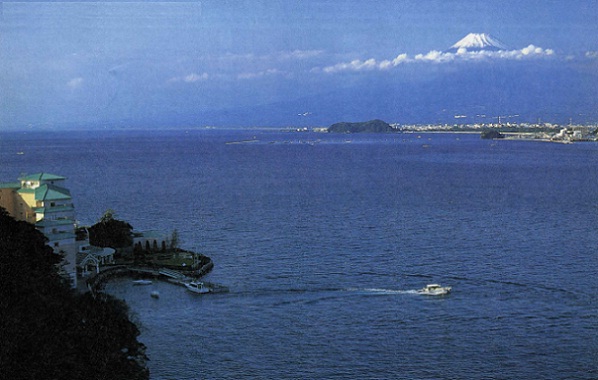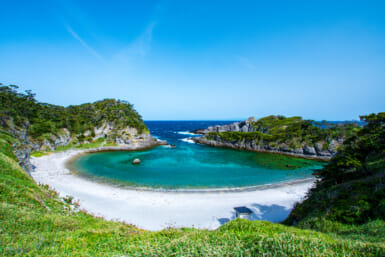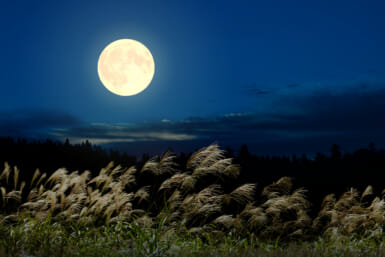by Tom Chapman
There is only one way to get to the Awashima Hotel from the mainland of Japan, but fortunately it is the stuff of good melodrama, and we take it. As the sleek private launch leaves Numazu Harbor and in smooth and effortless fashion glides across the waters of Suruga Bay, heading for Awashima Island off the Izu Peninsula, it requires only the slightest leap of the imagination to see that the entrance of this extravagant new hotel, which we are now approaching to spend the night, is actually a 300-meter stretch of water leading out to some of the deepest ocean known to man.
It is a fine travel moment, a perceptible thrill: What other hotel has quite such a lobby? When the National Geographic went exploring in Suruga Bay not so long ago with one of those underwater photographic robots, marine biologists researched in depths of 7,000 feet and found “a hidden oasis of life.” They made the most astounding discoveries: giant spider crabs, rare snipefish, cutlass fish, snake eels, a wire coral forest and layers of volcanic cinders from the hot ash that fell over the bay when Mount Fuji last erupted in 1707.
So, having safely crossed this unusual watery abyss and arrived seven minutes later at the hotel docking area, a little modern harbor festooned with flags, the feeling is already that we’ve embarked on a momentous weekend, and entered the realm of privilege.
Deluxe hotels, with extravagant features and comfortable amenities, are with us everywhere now, even in the most out-of-the-way and down-on-their-luck places, and so the debut of yet another is hardly cause for exclamations of awe. But the opening of the Awashima Hotel late last year, a quiet statement of luxury and elegance, seemed to raise the high stakes ante for extravagant room-at-the-inn adjectives.
For openers, some observers believe the Awashima Hotel, room-for-room, suite-for-suite (and there are only 60 of them, with accommodations for a maximum of 138 guests), each with a different interior decoration and, on each room ceiling, an individual hand-painted musical instrument adorned by French artists, might well be the most expensive hotel ever built. One figure I heard, including the ones of developing the island infrastructure to support the hotel amenities, was ¥43,000,000,000. Could this be true? Masters of polite evasion, key hotel executives dispute this figure, as well you might imagine they would, but are coy about revealing any costs.
In a moment of rare frankness, this is what they told me: “The hotel is very different. It is the personal reflection of one man’s life and love of culture. We are using the hotel for personal communications. It is our way of showing something interesting about Japan. We don’t know how much it cost. After the island was purchased eight years ago, we first spent four years and a lot of money improving the land. Probably the infrastructure cost would equal the costs of creating the hotel itself.
“We had to build roads. We had to build a pathway around the island large enough for guests to walk on. We had to replace the ropeway and cable car from the mainland to the island, with specially ordered cable. We had arduous negotiations with the fisheries union around the island, which took many months. We built a wine cellar with a natural temperature of 17-18 degrees Centigrade by digging a tunnel connecting the eastern and western sides of the island. The wine cellar now contains 4,000 carefully selected bottles.
“Also, this is an area famous for hot springs, yet Numazu city had never had one. It had never been dug. We tried to dig for one, and we were successful. All of these things were done long before construction of the hotel began.”
Is this the most expensive hotel in the world, I persisted. “It can’t be that expensive,” said the hotel executives. “But we made it look expensive.”
Let us count the ways: Marble from Italy and the Philippines. A lobby sculpture of Medusa. Bathroom towel warmers from France. Furniture from France and Italy. A stained glass painting in pastel colors of Mount Fuji, specially ordered from Italy. Distinguished restaurants, and the chefs to go with them. Hand-painted wall murals in a lovely Odyssey Concert Hall created by eight French artists brought especially to Japan for this purpose. A magnificent private collection of art. Chamber music performances on weekends.
A staff of more than 200, a staff-guest ratio of better than two-to-one (including, I was informed, several who work only to ensure that the lovely natural environment of the island is preserved and who also keep away mosquitoes). A heliport. A handmade sunset beach. A natural hot spring bath overlooking the ocean. A putting green (and if you prefer the real thing, there is helicopter service to the Fuji Ace Golf Course, owned by subsidiaries of the interlinked companies that built and own the island and the hotel).
An ocean aquarium with entertaining dolphins and seals. Gardens and terraces and eternal summer. Wandering the hotel, walking the grounds, marveling at the lengths one can go to satisfy whims, affirming its quality, I couldn’t keep from thinking of publisher William Randolph Hearst and his castle on the California hill, San Simeon. There are Hearstian parallels here, of course; the stuff of legends.
The Awashima Hotel is the result of the old adage that you can’t have a dream come true unless you have a dream. The childhood dream of Shoichi Osada, now 69, was to someday own and operate a hotel. Sidetracked momentarily, he went into the banking business, first in a small way, and then in a big way. Today, he is the Chairman of Tokyo Sowa Bank. But all of this financial success did not damper the dream to run a hotel.
When he learned eight years ago that privately owned Awashima Island, a historic place much revered by the local fishermen and villagers, was for sale because the children of the deceased former owner could not afford to pay the substantial inheritance taxes, Osada began to reverently nurture his dream. It was explained to me: “Awashima was the only island of this size available in Japan, and also the only one this large that was uninhabited. There were, of course, many animals and birds, and a shrine that was built in the mid-Edo Period. As a boy, Emperor Akihito once swam here. The Imperial Summer Palace is not far away. The Emperor has fond memories of his days spent at Awashima.”
Seen from a distance Awashima Island is not much to look at—a small, sharp, tree-covered hump in the ocean, about 134 meters high, 2.2 kilometers around, about 50,000 tsubo in total space. In aerial views it appears as a stately allegorical green ship at sea, knifing through placid waters. Above it all stands Mount Fuji, grandly snow-domed, looming like a stupendous sentinel. The hotel, a simple V-shaped structure only seven stories high, has a certain surprising radiance, like a soft virtue, a quiet turn of thought.
Three-dimensional and free of architectural adventurousness, it wraps around a jutting northwest portion of the island with flows and rhythms, adhering to the natural shape and slope of the landscape, conscious of a concern to preserve nature, subtly, inconspicuously colored to blend with the trees and shrubs of the slopes and hues of the sea. Tranquil, neutral in its integration, it seems to belong right where it is, in the manner of a natural force. A walking path curves comfortably up to Awashima shrine. Access to the island is reserved for hotel guests. They arrive by car or train from Tokyo, a two-hour journey. The Shinkansen drops them off at Mishima Station, from where they can ride the Izu Hakone Railway to Izu Nagaoka Station, or taxi in to Awashima harbor near Numazu, or arrive by the hotel’s private limousine service from Izu Nagaoka.
“Part of our uniqueness is the way we guard access to the hotel,” it was carefully explained to me. “Anyone can enter the lobby of the Okura or the Four Seasons hotels, but that’s not possible at our hotel, because only staying guests have access, and they must cross by our launch. There is a cable ropeway, but we also own and operate this. There is no bridge. Thus, no matter if all 60 rooms are rented out, the lobby will always be quiet because we never have outsiders.
“It may be a strange way of putting it, but we don’t want our hotel to be known to too many people. If it becomes too well known, the rooms will always be full.”
Why shouldn’t a place of dreams always be full? Mr. Osada seems to want a hotel atmosphere where his cultural orientations can be strongly felt. As a child, he wanted to be a writer; today, he is a widely published essay writer. He loves music; he wanted to have a concert hall in the hotel. He loves all art— painting, sculpture—the hotel is filled with his valuable collection, and observers have vivid memories of the hours he spent dictating the exact hanging of his art and the placement of his sculpture as the hotel neared completion.
“Part of Mr. Osada’s dream has been to display a segment of his art collection at the hotel,” it was explained.
With rates for a standard suite running from ¥60,000 a night on up to ¥400,000 for a special suite a night, the hotel is being marketed in special ways. It is thought inappropriate to promote a hotel like this in newspapers or magazines. “We are relying solely on personal recommendation, by word-of-mouth, if you please,” I was told. “We realize this way is slow and it is expensive, but you would be surprised to discover how many presidents of top Japanese and foreign corporations have already chosen to visit our hotel. And they have also indicated they would like to rent out the entire hotel on special occasions.
“In three years, we are convinced that the hotel will be booked constantly by important companies, for their guests. For a start, we do not care for a large profit, as long as we can pay our expenses. We have hopes that major corporations will use the hotel as a guest house, or to entertain their clients. Already there is much interest from Japanese corporations who have distinguished guests from abroad.
“Please remember that Mr. Osada has been a great traveler all his life. He has visited most foreign countries and every U.S. state. His philosophy is that to know more about Japan, you must know more about the rest of the world. This hotel is his way of having an atmosphere that is an expression of his life.”
(For reservations and further information, contact: Awashima Hotel, 186 Uchiura Shigedera, Numazu-shi, Shizuoka-ken, Japan 410-02. Telephone: 0559-41-3136; fax, 0559-41-3725. Website: www.awashima.com)









